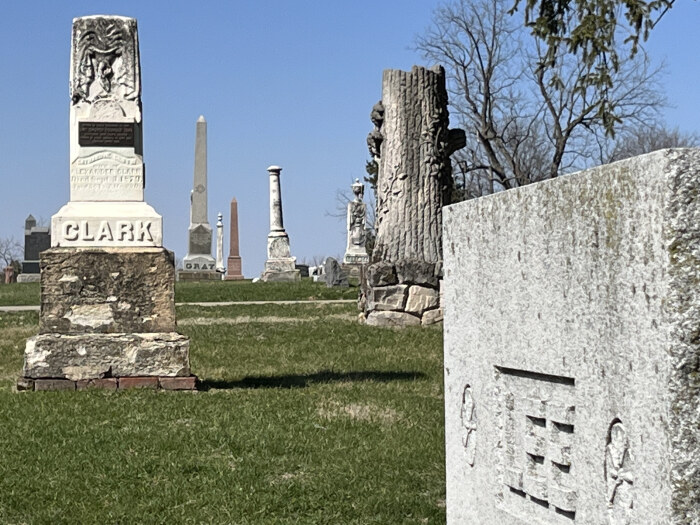This column by Daniel G. Clark about Alexander Clark (1826-1891) first appeared in the Muscatine Journal.
First we examine the white marble monument whenever I accompany visitors to Alexander Clark’s grave at Greenwood Cemetery. Then I tell about other family members buried there. Then I point to the adjacent plot where a large central stone is inscribed “Lee” on one side and “Mahin” on the other.
As friendly as they were in life, I say. I tell, as I do in these columns, about pioneer editor John Mahin (1833-1919) who led this newspaper for half a century. His close association with Clark appears to continue through graveyard neighborliness.
I can’t say how the eternal-rest deal came to pass, but I do say it’s not hard to guess.
Same with the Lees, I say.
In 1878 Mahin formed the Journal Printing Co. with two partners: father-in-law John B. Lee (1820-1904) and brother-in-law Alfred W. Lee (1858-1907).
John Mahin and Anna Lee married in 1864. A decade later, her 16-year-old brother “A.W.” went to work for John in the Muscatine post office. (Mahin was postmaster and ran the newspaper; he served a term in the legislature, too.)
Muscatine Journal, December 6, 1910: “[A.W.] remained in the postoffice [sic] for two or three years and then became a reporter on the staff of the Journal…. For some twelve years more he lived in Muscatine and rose rapidly in the Journal office, assuming within a few years much of the responsibilities and labors of the position of business manager, which his father, John B. Lee, had previously come from Iowa City to accept.”
Bette Veerhusen’s 1970s research concluded that A.W. boarded at the new Federal-style double house erected in 1878 by Alexander Clark. He may have lived there for several years, perhaps until after he married Mary Walker in 1885.
The Lee parents moved here in the late 1870s. It’s possible they lived in the Clark house, too, before settling into their long-term residence farther up West 3rd Street. I am still connecting dots, sifting clues, trying to learn more.
Muscatine Journal, June 28, 1904: “Though he had numerous relatives in the confederate army, Mr. [J.B.] Lee was a strong union man. and an abolitionist. …moved to Muscatine about 27 years ago, where he has lived ever since.”
Cedar Rapids Evening Gazette, June 4, 1885: “Fred is not only admired in Muscatine for his personal worth and fine ability, but he is very popular among the fraternity throughout the state. He is secretary of the Iowa Press association….”
A.W. Lee went on to achieve distinction as a publisher and founder in 1890 of the Lee Newspaper Syndicate—today’s Lee Enterprises—“leading provider of local news, information and advertising in 77 markets in 26 states (lee.net).”
* * *
Muscatine Journal, June 3, 1876: “The only colored printer in the State, Alexander Clark, Jr., is an employe of the Journal office, where he commenced to learn the business two years ago. He is a good compositor, a gentleman, and has won the confidence and esteem of his white fellow printers.”
In 1879 Clark (1856-1939) became the first Black graduate of the University of Iowa College of Law. In 1882 he joined his father and Ferdinand Barnett, one of Illinois’ first Black lawyers, in purchasing a Chicago newspaper.
Muscatine Journal, December 20, 1882: “Alexander G. Clark, who has personal charge of the Conservator in its mechanical department, learned ‘the art preservative of all arts’ in the JOURNAL office. He was an employe of this office nearly four years, and it is creditable alike to him as well as to his associates in the office that during all that time, notwithstanding the prejudice too often manifesting itself against colored persons employed on an equal footing with whites, no difficulty ever occurred between him and his fellow workmen, nor any bad feeling that came to the notice of his employers.”
* * *
From Little Known Stories of Muscatine by William D. Randall:
“[T]he Mahin lot in Greenwood Cemetery is on the exact location of the Jacob Mahin log cabin where John Mahin lived as a boy while working on the Bloomington Herald. … The cabin was situated on the bluff overlooking the river, and when little John came home after dark, his mother helped him find the isolated cabin by opening the front door so the light could be seen from what is now called Lucas Street but what was then a country road. Many years later, when the Greenwood Cemetery was expanding, John Mahin conceived the idea of purchasing the site of the log cabin and using the ground for the family burial lot. The Mahin lot is easily located; it is on the south side of the southerly road through Greenwood, west of the main road leading from the chapel entrance, near where the two roads intersect.”
* * *
View Dr. Paul Finkelman’s 2023 Alexander Clark Lecture, delivered on February 27 at Muscatine Community College.
Next time: What became of Susie Clark?
Top image: Clark monument at Greenwood Cemetery, Muscatine. Lees and Mahins share adjoining plot.

